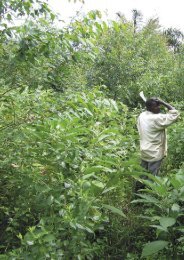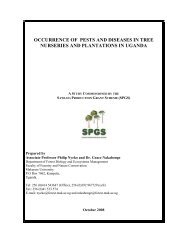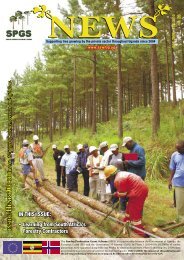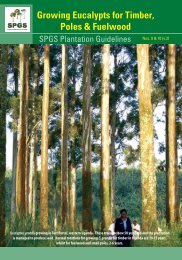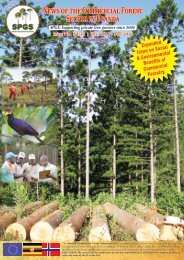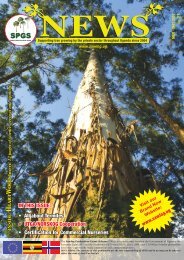download - SPGS
download - SPGS
download - SPGS
Create successful ePaper yourself
Turn your PDF publications into a flip-book with our unique Google optimized e-Paper software.
SAWLOG PRODUCTION GRANT SCHEME - MAY - JULY 2009. ISSUE NO. 24<br />
Forest<br />
Fires by Bric Milligan<br />
A burnt private plantation near Hoima (Jan. 2009).<br />
Over just a couple of<br />
weeks early in 2009,<br />
nearly 100ha of <strong>SPGS</strong><br />
clients plantations were<br />
wiped out by fires in<br />
just one district - and those are just<br />
the ones we are aware of!<br />
We rushed out once we were told of<br />
them and had a look to see how such<br />
losses could be averted in the future.<br />
Although these fires are tragic we did<br />
noticed three main things that could<br />
have reduced or even prevented the<br />
damage:<br />
1. All the fires came from outside<br />
the plantations and did not seem<br />
to be started with the purpose of<br />
burning the trees. So if there were<br />
people on site looking out for<br />
fires they would have seen them<br />
coming and could have made<br />
plans to tackle the fires before they<br />
reached the plantations. Talking<br />
to the neighbouring communities<br />
and asking to be informed about<br />
fires that could pose a risk would<br />
also have helped.<br />
2. Almost all of the external<br />
firebreaks were too narrow for the<br />
type of vegetation that they were<br />
protecting. In some cases the bush<br />
was higher than the firebreak<br />
was wide. A firebreak needs to<br />
be wide enough to stop the fires<br />
along the ground so that if the<br />
bush on the outside is almost five<br />
metres in height, the belt must be<br />
wider. Some of the firebreaks were<br />
covered in dry grass so that they<br />
were in fact not firebreaks at all!<br />
3. All of the plantations that were<br />
burnt were bushy so that once<br />
the fire had entered there was<br />
lots for it to burn. If you are in a<br />
dry district make sure that your<br />
plantations are relatively clean of<br />
weeds especially approaching the<br />
dry season.<br />
Those are three points that would<br />
have helped without even having to<br />
have to actually fight the fire. It is of<br />
course very important to have people<br />
and equipment to be able to attack the<br />
fire quickly and effectively as soon as<br />
it starts burning: often it is even better<br />
to put out the fire before it enters your<br />
plantation. Better planning will lead<br />
to safer plantations. Read the Fire<br />
Protection Chapter in the new <strong>SPGS</strong><br />
Tree Planting Guidelines for Uganda<br />
– for more information.<br />
BRIC – IN HIS<br />
OWN WORDS<br />
The time is drawing near for me<br />
to bid my farewells to Uganda,<br />
as many of you know I will<br />
be leaving towards the end<br />
of May to take on a new challenge in<br />
Tasmania, Australia. I have been in<br />
Uganda just over four and a half years<br />
and all in all I can say that it has been a<br />
great experience and I am very grateful<br />
that it was possible for me to have<br />
experienced it.<br />
On the work side of things it has been on<br />
of the most gratifying work experiences<br />
that I have had. The level of dedication<br />
from the growers, investors and staff<br />
has been wonderful and the willingness<br />
to improve has been great. Sometimes it<br />
is a daunting situation when everything<br />
you say is being written down and<br />
memorized and then implemented in<br />
the field. It puts a lot of pressure on you<br />
to make sure that you get what you are<br />
trying to portray across correctly. Also<br />
it is gratifying to see so much progress<br />
in the time that I have been here:<br />
thanks to the whole <strong>SPGS</strong> team you can<br />
see visible improvements in attitudes,<br />
standards and especially in areas of<br />
good, well-managed plantations. It has<br />
been an honour to have been part of<br />
all that.<br />
What I hope to see should I come<br />
back and visit is a lot of progress on<br />
the nursery side of things. The lack of<br />
professional, containerized nurseries<br />
to supply good quality seedlings to the<br />
growers is proving to be a weak link<br />
in the chain. Of course in the longer<br />
term it would be great to see efficient,<br />
modern processing plants being set up<br />
here too and good returns being made<br />
on the investments that seem to be<br />
emptying your pockets quicker than<br />
you had imagined.<br />
Outside of work my wife and children<br />
have made many friends and have<br />
really loved living in Uganda. The<br />
friendliness of the people and the<br />
beauty of the country are wonderful.<br />
Even though we come from South<br />
Africa we have come to love Uganda<br />
as our home and pray for it each and<br />
every day as it has so much potential.<br />
We have been fortunate to visit many<br />
parts of the country and even though it<br />
Cont’d on p. 18<br />
NEWS OF UGANDA’S COMMERCIAL TREE PLANTING FUND FOR THE PRIVATE SECTOR<br />
17



